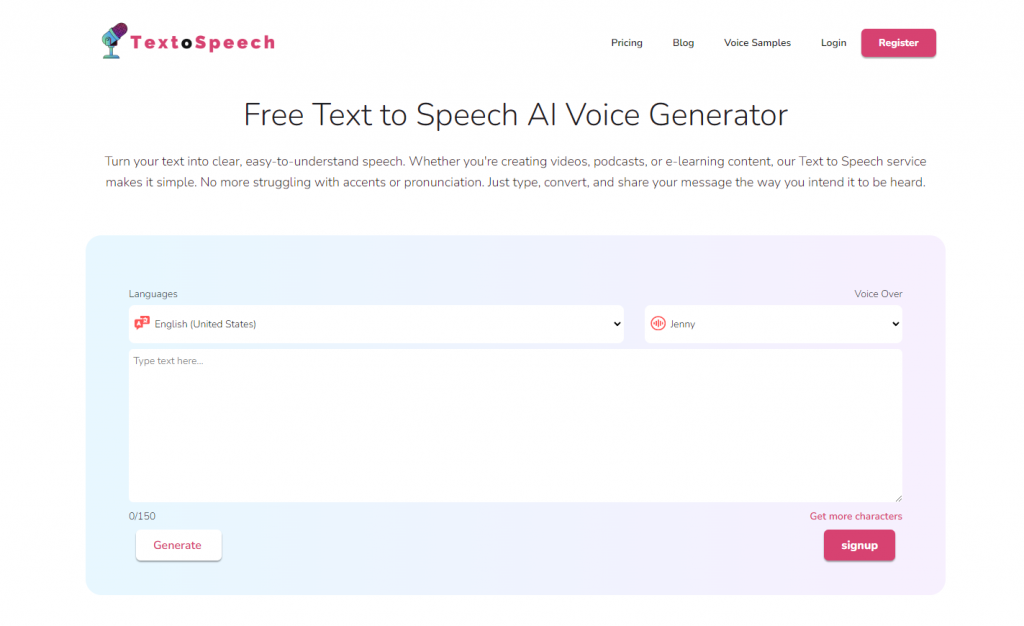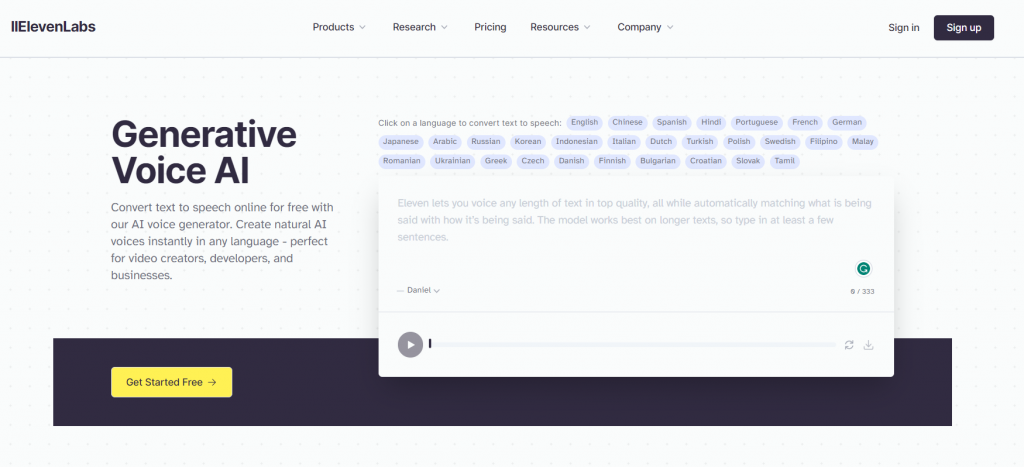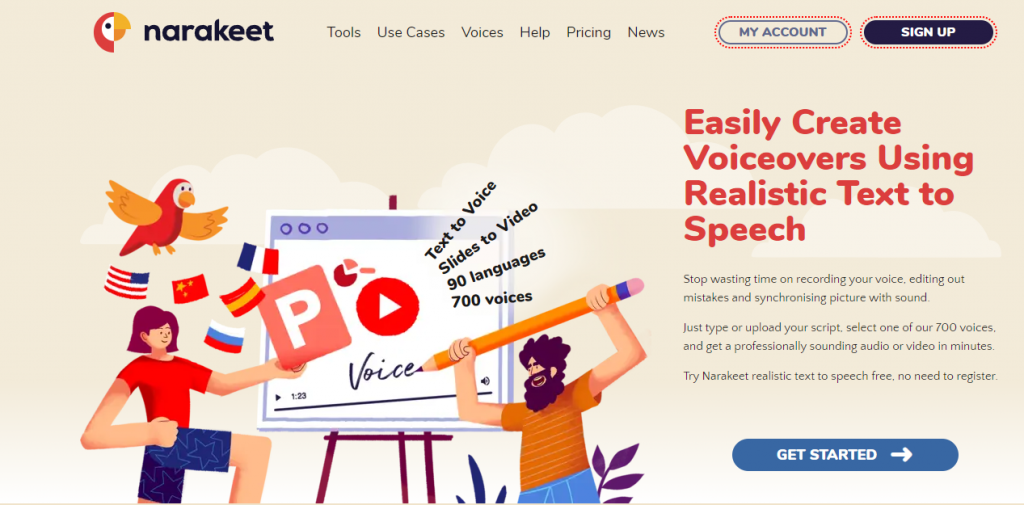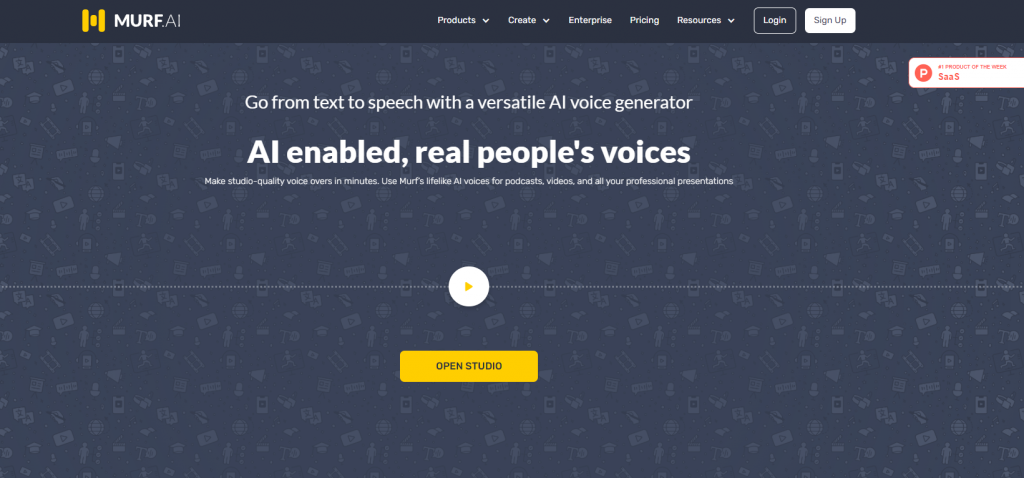In the world of AI-generated videos, the magic of converting written words into spoken language is done by text-to-speech (TTS) tools. These tools help in creating engaging and lifelike voiceovers for various content types.
In this article, we will discuss the top 5 best text-to-speech services specifically designed for AI-generated videos, highlighting their unique features and how they can enhance your video content.
Top 5 Best Text To Speech For AI Generated Videos
1. TextoSpeech

TextoSpeech is a tool that turns written text into spoken words. It’s great for making AI-generated videos sound more natural. This tool offers a variety of voices and languages, so videos can reach a wider audience.
The voices sound real, not robotic. This makes the videos more engaging and easier to understand. It’s perfect for content creators who want their videos to be clear and enjoyable.
In short, TextoSpeech is user-friendly and flexible. It’s an excellent choice for anyone looking to add high-quality speech to their AI-generated videos. It helps in making content that’s both appealing and accessible to everyone.
Features of TextoSpeech
- Supports over 50 languages and 300 voices, providing a diverse range of content needs.
- Provides an easy-to-use text editor with real-time preview for fine-tuning voiceovers.
- Flexible pricing plans, including a free version, low-cost subscription options for advanced features, and a lifetime plan.
- Natural-sounding voices that are ideal for YouTube videos and multimedia projects.
- Web-based platform, ensuring accessibility and convenience without the need for software installation.
- Fast processing speeds allow for faster turnaround on voiceover projects, increasing productivity.
Pros and cons of TextoSpeech
Pros
- Variety of Voices and Languages
- Ease of Use
- Time-Saving
- Cost-Effective
- Consistency
- Accessibility
Cons
- Limited Features in Free Version
- Lack of offline functionality
2. ElevenLabs

ElevenLabs offers a Text to Speech service that’s great for making AI videos. It turns written words into spoken ones, like a real person talking. This is super useful for creating videos without needing a real person to record the audio.
Their technology makes the voice sound natural and clear. You can choose from different voices to find the best fit for your video. This makes your videos more engaging and helps deliver your message effectively.
Using ElevenLabs is quite easy. You just input your text, pick a voice, and the system does the rest. This saves a lot of time and effort, especially if you’re making lots of videos.
Features
- Generates high-quality audio from text using AI algorithms.
- Offers pre-designed voice profiles and the ability to create new voices from audio snippets
- For long-form content creation, such as audiobooks, with contextually-aware voices.
- Translates and preserves original voice characteristics in over 20 languages.
- Utilized by publishers and authors for AI-narrated content.
- Sets rules against misuse, supporting artistic and political speech
Pros and cons
Pros
- Human-Sounding Voices
- Versatile and Realistic AI Speech
- Voice Lab Feature
- High-Quality Audio
- Voice Library
- Intuitive Interface
Cons
- Control over the final aspects
- Huge number of features
- High Learning Curve
3. MicMonster

MicMonster offers high-quality text to speech voices perfect for narrating AI generated video content. The voices sound natural and humanlike. There are multiple voice options to choose from, with both male and female voices available.
The clear voices and convenient service make MicMonster ideal for narrating AI generated explainer videos, commentary, product reviews, and other automated video content. Without needing to record your voice, you can add realistic voiceovers to synthetic videos.
MicMonster provides an affordable and easy way to vocalize AI generated video scripts. The voices flow smoothly and sound almost human, fitting for a range of automated video use cases.
Features
- Over 600 voices are available, covering 140 languages and catering to diverse linguistic needs.
- Advanced AI technology enables it to infuse emotions into voiceovers, adding authenticity and reliability.
- UMicMonster offers natural, human-like voices.
- Delivers exceptional audio quality with a 384 Kbps Bitrate for an immersive listening experience.
- Offers control over the emotion and tone of voiceovers, enhancing realism and engagement.
- Allows flexibility in adjusting pitch and speed to suit specific project contexts.
Pros and Cons
Pros
- Wide Range of Voices and Languages
- User-Friendly Interface
- Speed of Conversion
- Customization
Cons
- Lack of Natural-Sounding Voices
- Limited Emotional Range
- Contextual Limitations
4. Narakeet

Narakeet offers high-quality text to speech perfectly suited for vocalizing AI generated video content. The voices sound very natural and human. You can choose from many realistic male and female voices with different accent options.
The clear audio makes it easy to add voiceovers to synthetic talking head videos, animated explainer videos, product reviews, commentary, and more AI content. For narrating a range of AI video use cases, Narakeet is an ideal text to speech service.
Narakeet provides an affordable way to add realistic voiceovers to automated videos generated by AI. The smooth, natural sounding voices flow well and sound almost human.
Features
- Offers over 700 voices across 90 languages, catering to a global audience and diverse content needs.
- Includes background music options, sound effects, and the ability to adjust speech speed and pitch for customized voiceovers.
- Easy-to-use script editor and the ability to convert PowerPoint presentations directly into narrated videos.
- Flexible pricing plans, including pay-as-you-go and subscription options, are suitable for various user needs and budgets.
- High-quality, natural-sounding voices enhance the overall audio experience of your content.
- Easily integrates with various content creation workflows, streamlining the process of adding voiceovers to videos and presentations.
- Wide accessibility with support for multiple languages and dialects, making it ideal for creating content for international audiences.
Pros and Cons
Pros
- Variety of Voices and Languages
- Ease of Use
- Time-Saving
- Cost-Effective
- Consistency
- Accessibility
Cons
- Limited Features in Free Version
- Lack of offline functionality
5. Murf AI

Murf AI Murf AI offers advanced text to speech perfect for vocalizing AI generated video content. The voices sound incredibly realistic and human.
You can select from many natural-sounding male and female voices with different accent options. Simply enter your script and Murf AI generates a smooth, professional voice recording.
The clear audio makes Murf AI ideal for adding voiceovers to automated explainer videos, animated videos, talking heads, product reviews, commentary, and other AI video content.
Murf AI provides a convenient way to add natural voiceovers to synthetic videos made by AI. The exceptionally realistic voices flow smoothly and sound human.
Features
- Murf AI offers over 120 voices across 20 different languages, catering to a global user base.
- Includes voice cloning, AI dubbing, and integration with Canva for enhanced voice-over capabilities.
- Advanced text-to-speech editor, voice modulation options, and real-time voice editing for precise control.
- Flexible pricing plans, including a free trial, basic, pro, and enterprise levels, to suit different user needs.
- High-quality, lifelike AI voices are ideal for professional and personal projects.
- User-friendly interface, making it accessible for beginners and experts alike.
- Extensive library of AI voices, including options for different ages, accents, and styles.
Pros and cons
Pros
- Wide variety of voices
- Extra Effects
- Google Slides Add-on
- Performance
- Scalability
Cons
- Cost
- Learning Curve
- Reliability
- Customization
FAQs
What is Text To Speech (TTS) for AI-Generated Videos?
Text To Speech (TTS) for AI-Generated Videos is a technology that converts written text into spoken audio, allowing AI systems to generate human-like voices for video narration or dialogue.
How does Text To Speech (TTS) enhance AI-generated videos?
TTS enhances AI-generated videos by providing a natural and engaging voiceover, making the content more accessible and engaging for viewers. It eliminates the need for human voice actors in video production.
What are the benefits of using TTS for AI-generated videos?
Some benefits of using TTS in AI-generated videos include cost savings, scalability, customization of voices, multilingual support, and the ability to generate content quickly.
Which TTS tools or platforms are suitable for AI-generated videos?
There are several TTS tools and platforms available, including Google Text-to-Speech, Amazon Polly, IBM Watson Text to Speech, and more. The choice depends on factors like quality, pricing, and integration options.
Conclusion
When looking at the top 5 text-to-speech tools for AI-generated videos, TextoSpeech stands out. It’s known for turning text into natural-sounding audio, making videos more engaging.
This tool helps create a clear voiceover, which is key for a good viewer experience. Picking the right tool, like TextoSpeech, can make your videos shine. It’s about finding a voice that speaks to your audience and brings your content to life.

